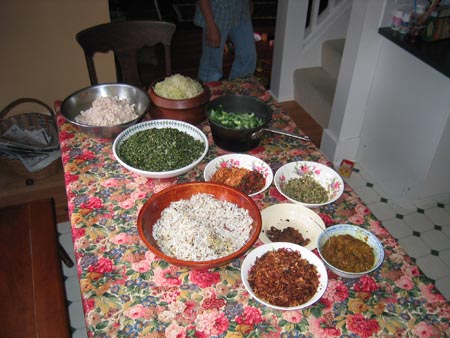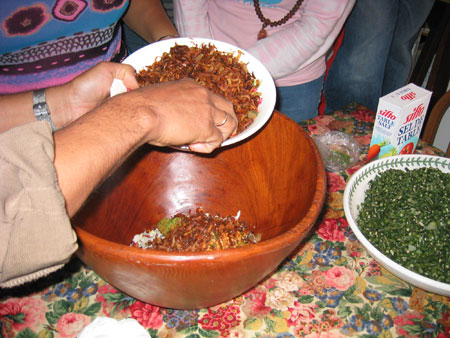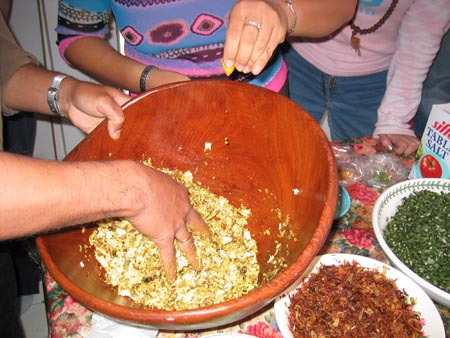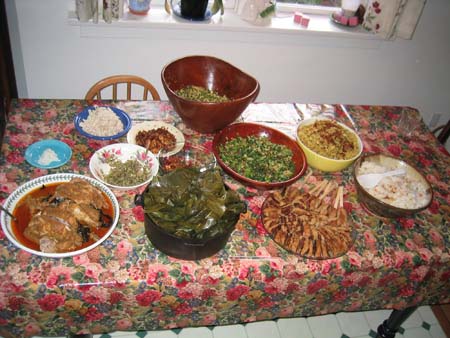| recipes |
LAWAR If you have not been to Bali and had lawar there, it is unlikely that you have ever heard of it. No Indonesian restaurant that I know of has it...even among the many that call themselves " Bali " to capitalize on the island's fame. This is because lawar is exceedingly complex to make, requires a whole cooking crew and many hours, and is impractical to make in small, restaurant-sized amounts. It cannot be made in advance either, and must be consumed right away or it begins to sour. No one taught me how to make lawar, although I asked for instructions many times. The procedure is too complex to submit to succinct explanation, and I was always told to watch and learn that way. So I did...dozens if not hundreds of times. The process of making lawar is called "mebat", a verb meaning to chop. The process begins at dawn on feast day, when people gather together and begin making the tek-tek-tek sounds of their heavy knives going at the meat, spices or vegetables on wooden cutting surfaces. Many hands make light work, and much fun is always had. The meal is usually ready in late morning. At the April 2003 lawar meal documented here, I assumed the role of photographer. The head chef was Nyoman Wenten, a renowned Balinese dancer who lives in California . Spices and ingredients for lawar, with Balinese terms. Back row, left to right: 1. garlic (bawang putih), 2. yams (ketela), 3. coconut (nyuh), 4. lemon grass (sereh), Not shown: cooking oil (lengis), chicken (be siap), vegetables (jukut) Vegetables (jukut) for use in lawar.
Making lawar is labor intensive, requiring at least four people and four to five hours' work. The first step is to peel and finely mince 50-75 shallots, 8-10 bulbs' worth of garlic, and 3-4 large handfuls of small chilis. Set all of these aside in separate bowls. Then peel at least a fistful's worth of all the roots: turmeric, ginger, laos, and kencur. Set aside about 1/3 of the onions, garlic, chilis, for the spice paste. Reserve the rest for frying.
The chilis should be cut in small rounds, as shown, but do not seed them.
In a typical lawar feast several different kinds of lawar are made. These are all essentially the same except for the vegetable used. Here long beans, which have been boiled for about 10 minutes until done, are drained well, chopped fine, and set aside. The green papaya shown in was first cut into strips, then also pre-boiled, drained, grated and set aside.
The chopped shallots are fried on the stove in enough oil (Balinese use coconut oil, but I prefer canola oil) to cover over a medium flame. They must be watched and stirred constantly. After some time they will brown and crisp. Before they brown too much, remove them with a slotted spoon and quickly transfer them to a paper bag or paper towels to drain. The fried onions are called mba. Many are needed, and usually several batches must be fried. Now add the chilis, again to the same oil. When they brown, drain them and set aside. Remove all but about 4 tablespoons of oil. To this add a crushed, thumb-sized piece of shrimp paste and fry. Watch out for the smell! Almost immediately add a large, finely chopped chunk of kencur. When the kencur has browned turn off the flame. Pour the oil, shrimp paste, and kencur into a small bowl and set aside.
Here is a bowl of nice crisp mba, showing the proper color.
...and here are the fried, crispy garlic and the chili rounds, sharing a bowl.
This is the basa gde (complete spice paste). It is made as follows: The precise amounts and combinations of these are something I have never measured or been too fastidious about. Every time it tastes different, and one gets the knack after a while. No two Balinese cooks prepare basa gde the same way, either. Since I am not a professional cookbook author, I feel no obligation to be more specific than this. One must develop one's own spice paste style. When all ingredients are combined, fry in a generous amount of oil until deep yellow (from the turmeric). Let cool and set aside.
At the beginning of the lawar preparations, crack open three or four large coconuts, discard the water inside (unless needed for something else; but Balinese rarely use this), and scoop the meat out, including the brown inner skin.The husks and shell may be saved and used as coal for grilling sate, as they burn fragrant, hot, and long-but that is another recipe entirely. Break the coconut into fist-sized chunks and roast in the oven at 400 for about 30 minutes until the edges start to brown like toast. This releases all the oils and gives the coconut a wonderful odor and flavor. Remove and grate--not too finely--and set aside.
Here are the finished basic components of the lawar, which can now be mixed. They are:
1. Rear-left, in metal bowl: 2 large chicken breasts which have been boiled, skinned, boned, and shredded by hand. (N.B.: Each of these three vegetables will be used to make a separate lawar, but all of the other ingredients are the same.) 5. Center, in small flower pattern bowl: fried garlic and chili. Now we can begin mixing the lawar: In a large bowl, begin with several handfuls of the roasted, shredded coconut. Add several spoonfuls of spice paste.
To the coconut and spice paste, generously sprinkle in finely snipped kaffir lime leaves.
Now add in the mba, and be generous. Also add (though it is not shown in the photos) several spoonfuls of the mixture of oil, shrimp paste and kencur described earlier.
Add some of the fried garlic and chili to the coconut, spice paste and lime leaves.
Now add two or three generous handfuls of the boiled, shredded chicken meat. Wash your hands, roll up your right sleeve, and knead everything in the bowl together thoroughly, working it with the fingers to get a smooth blend. To everything combined, add an equal or slightly greater volume of one of the vegetables-in this case, papaya. Knead everything together again. The lawar is basically ready now, but it needs final seasoning and tasting.
Next you can add, to taste, some salt and kaffir lime (or other small Southeast Asian citrus) juice. The Balinese word for "not salty enough" is nyem, which also means "crazy."
Mix the whole some more. Try a taste. Is the spice paste intense enough? Are all the flavors coming through? Is it well blended? Does it leave a nice hot glow on your tongue? Add a bit more coconut, meat, vegetables, spices, fried onions, or anything that is needed. It is beyond me to describe the range of great lawar flavors that can be aimed for; you will have to set and meet your own standards. Now take another large bowl and repeat the entire process, substituting one of the other vegetables for the papaya. Sambal Goreng: When all the lawar is done, take the remaining fried onions (mba), fried garlic, fried chili, and oil-kencur-shrimp paste mixture and combine in a small bowl. Add salt. This amazing substance is called sambal goreng (fried condiment), and once you taste it you will wish you had doubled the amount of shallots you fried earlier in the day. Later when eating the lawar with rice, take a small amount and put it on the side of the plate, adding just a bit to each bite you take. It is bliss for spice lovers. Here is the complete lawar feast we made. It includes:
|
.jpg)
.jpg)
.jpg)
.jpg)
.jpg)
.jpg)
.jpg)
.jpg)
.jpg)
.jpg)

.jpg)
.jpg)
.jpg)

.jpg)
.jpg)

